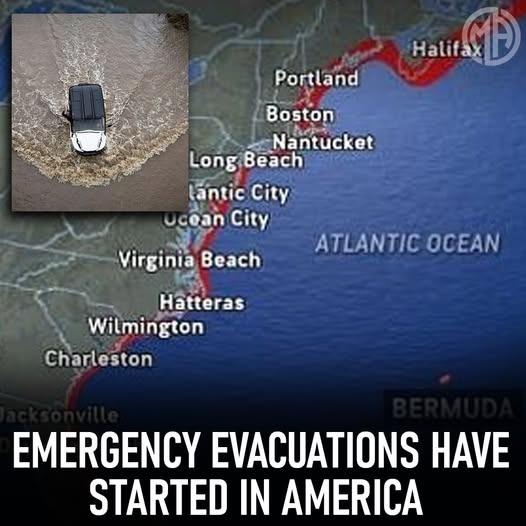The U.S. East Coast is facing one of its most alarming storm threats in years, as Hurricane Erin rapidly strengthened beyond initial forecasts, forcing officials to order mass evacuations across multiple states. From Florida up to New England, millions of residents are being urged to flee low-lying areas as the Category 4 storm barrels toward landfall with unprecedented speed.

A Storm That Grew Too Fast
Meteorologists admitted the storm’s rapid intensification caught even seasoned experts off guard. Within 48 hours, Erin transformed from a manageable system into a catastrophic hurricane, drawing comparisons to some of the most destructive storms in U.S. history, including Hurricane Katrina and Hurricane Sandy.
Satellite imagery shows the hurricane stretching across hundreds of miles, threatening major cities such as Miami, Charleston, Virginia Beach, Atlantic City, Boston, and even New York City. With winds exceeding 140 mph and storm surges predicted to reach record levels, Erin has set off one of the largest coordinated emergency responses in years.
Cities on Lockdown, Highways Jammed
Evacuation orders were issued across coastal communities, with states including Florida, the Carolinas, and New Jersey declaring states of emergency. Highways are already seeing miles-long traffic jams as residents rush inland. In Virginia Beach, shelters have reached near capacity, while in Boston, officials are warning residents to prepare for widespread power outages and possible infrastructure collapse.
The situation is particularly dire for communities that are still recovering from previous storms. Many towns along the Carolina coast, already vulnerable due to eroded shorelines, are expected to face catastrophic flooding.
Federal and Local Response
President Biden has mobilized FEMA and the National Guard, with thousands of troops ready to assist in evacuation, search-and-rescue operations, and disaster relief. “This storm is moving faster and hitting harder than anyone expected,” FEMA Administrator Deanne Criswell said in a press briefing. “We urge everyone in the evacuation zones to leave immediately. Lives are at stake.”
Airlines have canceled hundreds of flights, and Amtrak suspended service in affected regions. Hospitals along the East Coast are moving patients inland, and utility companies are bracing for what could be weeks of widespread blackouts.
The Global Impact
Beyond the immediate human toll, Hurricane Erin is already sending shockwaves through global markets. Oil refineries along the Gulf and East Coast are shutting down operations, sparking concerns about fuel shortages. The agricultural sector also faces severe risks, with major crop-producing areas threatened by flooding and wind damage.
Climate scientists are pointing to Erin as yet another example of extreme weather fueled by climate change, noting that warming ocean waters are a key factor behind the hurricane’s explosive growth.
A Nation Holds Its Breath
For now, all eyes remain on the storm’s projected path. If Erin makes direct landfall near a major metropolitan area, the economic and human costs could be devastating. With evacuation orders underway and emergency sirens sounding across multiple states, the East Coast is bracing for what could become one of the most destructive hurricanes in American history.
👉 Do you think Hurricane Erin will rival Katrina and Sandy in its devastation — or is America better prepared this time?